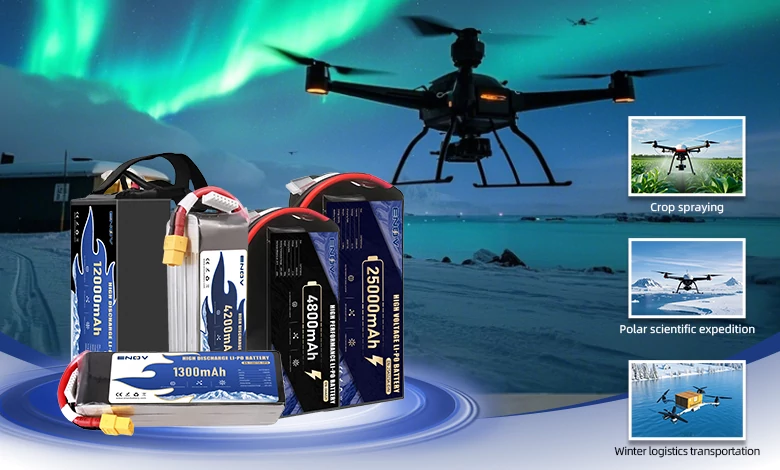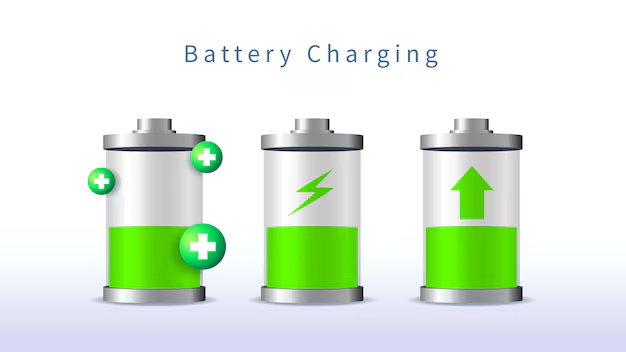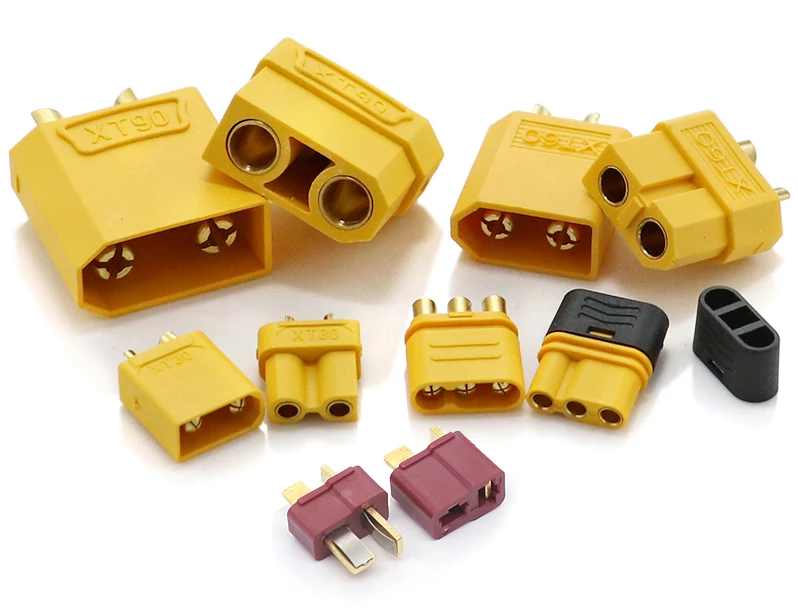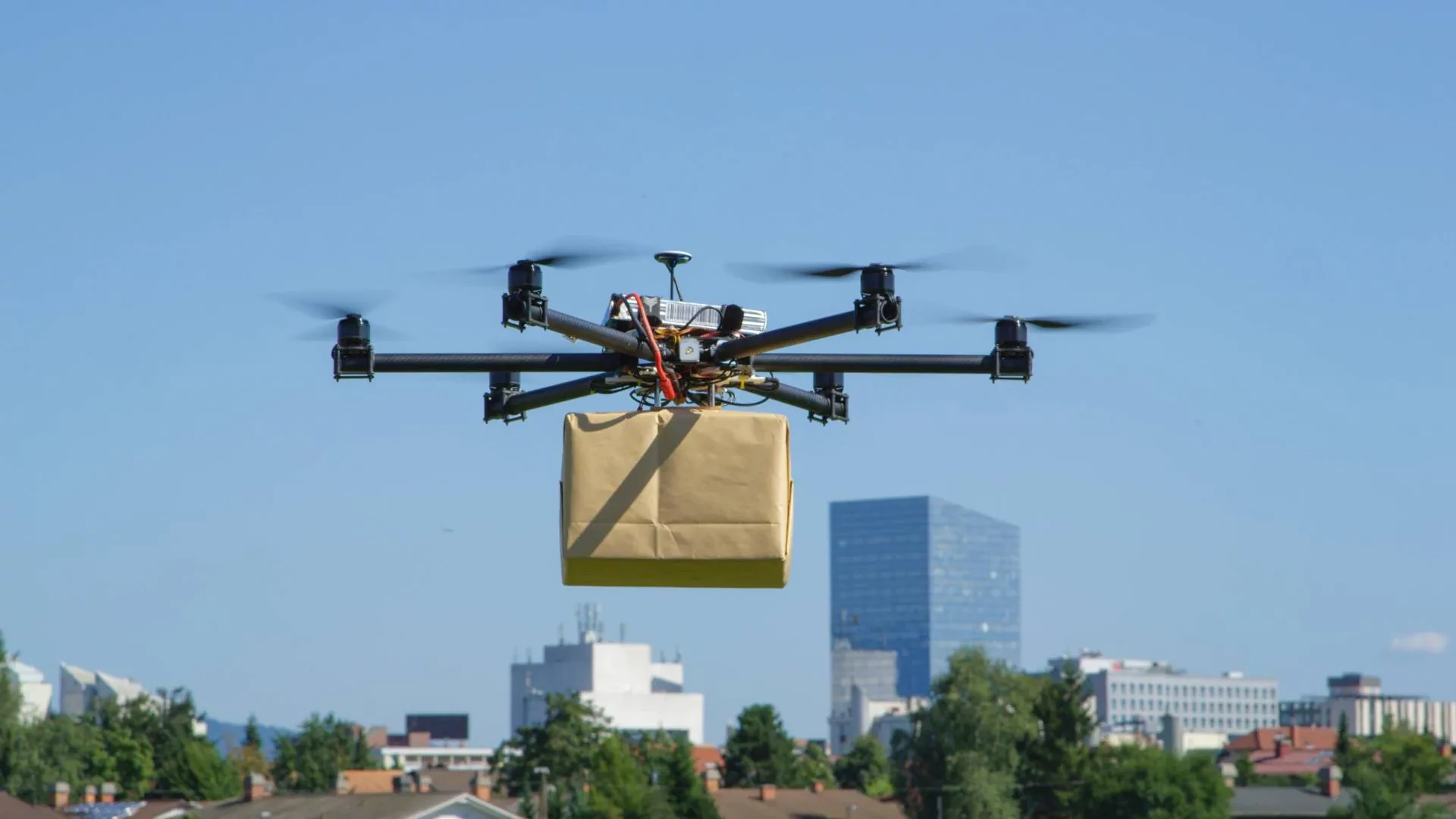Detailed Explanation of Drone Battery Structure

ENOV High-Energy drone batteries power industrial and commercial drones. Delivering 220–320 Wh/kg energy density, they enable long flight times (30+ mins) and support fast charging (2C). Perfect for aerial photography, surveillance, and delivery drones.
As the core power source of a drone, the performance of the drone battery directly affects the drone’s flight duration, safety, and control stability. Currently, mainstream drone batteries are centered on lithium-ion batteries, among which lithium-polymer batteries (LiPo) are the most widely used. In terms of the overall structure, a drone battery can be disassembled into three major modules: the core energy unit, the safety management system, and the external protection and connection components. These modules work in synergy to meet the drone’s requirements for high energy density, lightweight design, and high safety.
I. Core Energy Unit: Battery Cell
The battery cell is the core component of a drone battery for storing and releasing electrical energy, equivalent to the “energy heart” of the battery. Its internal structure and material selection directly determine the battery’s capacity, voltage, discharge performance, and safety upper limit. Each battery cell consists of four key components: a positive electrode, a negative electrode, an electrolyte, and a separator. All these components are sealed in a specific container. Depending on the application scenario, the sealed containers are divided into two types: soft-pack and hard-case. Soft-pack battery cells are mostly encapsulated with aluminum – plastic film and are commonly used in consumer-grade drones; hard-case battery cells are usually enclosed in metal casings and are more suitable for industrial-grade drones.
(I) Core Components of the Battery Cell
① Positive Electrode: It mainly adopts lithium composite oxide materials, with common types including lithium cobalt oxide (LiCoO₂), lithium manganate (LiMn₂O₄), lithium iron phosphate (LiFePO₄), and high-nickel ternary materials (NCM/NCA). Different materials have significant differences in characteristics: Lithium cobalt oxide has a high energy density, which can provide longer battery life for drones, but its high – temperature resistance is relatively weak; lithium iron phosphate has outstanding safety performance and a low risk of thermal runaway, making it suitable for industrial scenarios with high stability requirements; high – nickel ternary materials balance energy density and power output, and are a common choice for mid – to high – end consumer – grade drones. The core function of the positive electrode is to release lithium ions during the discharge process, and its performance directly determines the upper limit of the battery’s capacity and voltage level.
② Negative Electrode: The mainstream material is graphite, and some new-type battery cells use silicon-based materials or silicon-oxygen composite materials. Graphite has become the most widely used negative electrode material at present due to its mature manufacturing process and stable “lithium ion intercalation-deintercalation” performance; silicon-based materials can significantly improve the battery’s energy density because of their higher lithium ion storage capacity, but their cycle life still needs to be optimized. The core function of the negative electrode is to adsorb the lithium ions released by the positive electrode during charging, and during discharge, allow the lithium ions to deintercalate and return to the positive electrode through the electrolyte, while releasing electrons to form an electric current to power the drone.
③ Electrolyte: It is divided into two categories: liquid electrolyte and solid electrolyte. The liquid electrolyte is a mixture of carbonate solvents and lithium salts, and is the mainstream choice for current lithium-polymer batteries. It can provide an efficient transport channel for lithium ions and at the same time insulate electrons to avoid short circuits; the solid electrolyte is based on solid polymers or inorganic ceramic materials, which have higher safety and can greatly reduce the risks of liquid leakage and thermal runaway, but its cost is relatively high, and it is still in the stage of gradual promotion. The core role of the electrolyte is to act as a “bridge” for the movement of lithium ions between the positive and negative electrodes, and its conductivity directly affects the charging and discharging speed of the battery.
④ Separator: It mainly uses polyolefin porous membranes, such as polypropylene (PP) and polyethylene (PE), and some high-end products use multi-layer composite membranes. The separator has two core functions: one is to physically separate the positive and negative electrodes to prevent direct contact between them, which could cause a short circuit; the other is to allow the passage of lithium ions, ensuring the normal charging and discharging of the battery. In addition, high-quality separators also have the “thermal shutdown” characteristic – when the battery temperature is too high, the pore size of the separator will shrink automatically, blocking the migration of lithium ions, thereby cutting off the current and preventing the further aggravation of thermal runaway.
(II) Battery Cell Combination Methods
The drone motor has specific requirements for voltage and capacity, and a single battery cell cannot meet these needs. Therefore, multiple battery cells need to be combined in series (S) and parallel (P) ways. The core purpose of a series connection is to increase the total voltage. For example, when 3 battery cells are connected in series (3S), each cell has a nominal voltage of 3.7V, and the total voltage can reach 11.1V, which can meet the voltage requirements of the motors of most consumer – grade drones; when 6 battery cells are connected in series (6S), the total voltage can reach 22.2V, which is suitable for high – power industrial – grade drones. The core function of a parallel connection is to increase the total capacity. For instance, if 2 groups of 3S battery cells are connected in parallel (3S2P) and each single cell has a capacity of 5000mAh, the total capacity can reach 10000mAh, which can significantly extend the flight time of the drone. In practical applications, the battery cell combination method needs to be flexibly designed according to the power requirements and battery life goals of the drone. Common combinations include 3S1P, 4S2P, 6S1P, etc.
II. Safety and Management Core: Differences Between Battery Management System (BMS) and Basic Protection Functions
In terms of the safety management of drone batteries, there are two different designs: “smart batteries” and “ordinary batteries”. The core difference lies in whether they are equipped with a complete Battery Management System (BMS), which directly determines the battery’s safety protection capability, lifespan stability, and ease of use.
(I) Safety Management of Smart Batteries: Comprehensive Protection and Optimization Centered on BMS
A smart battery is equipped with a complete Battery Management System (BMS), which is composed of a hardware circuit and a microcontroller unit (MCU). It is equivalent to the “brain and bodyguard” of the battery and can realize multi-dimensional safety protection and performance optimization. Its specific functions can be divided into three parts: hardware protection, intelligent control, and data interaction.
① Hardware Protection Components: Building a Multi-layer Safety Barrier
Voltage Detection Circuit: It monitors the voltage of each battery cell in real-time. Since smart batteries mostly adopt a multi-cell series design (such as 3S, 6S), the voltage of each cell is prone to differences. This circuit can accurately capture the voltage changes of a single cell, preventing a cell from being damaged due to overcharging (exceeding 4.2V) or over-discharging (below 3.0V), and thus blocking the risk of cell bulging and fire from the source.
Current Detection Circuit: It monitors the charging and discharging current through a shunt or a Hall sensor. For the scenario of an instantaneous large current when the drone takes off and climbs, this circuit can identify the overload current in real-time, avoiding the accelerated aging of the battery cell due to overheating, and at the same time preventing damage to the internal structure of the battery cell caused by large current during charging.
Temperature Detection Circuit: It has a built-in Negative Temperature Coefficient (NTC) thermistor to continuously monitor the internal temperature of the battery. When the temperature exceeds the normal working range (0~45℃), the circuit will immediately feed back a signal to provide a basis for subsequent protection actions and prevent thermal runaway from being triggered by high temperature.
Protection Switch (MOSFET): As the “executive mechanism” of the BMS, when any of the voltage, current, or temperature parameters exceeds the safety threshold, the MOSFET will quickly disconnect the charging and discharging circuit to realize the four – fold protection of “overcharging, over – discharging, over – current, and over – temperature”, directly preventing the escalation of dangers.
② Intelligent Control Functions: Extending Battery Life and Ensuring Stable Performance
Balanced Charging: To address the problem of voltage imbalance in multi-cell series connections, the BMS will separately charge the “underperforming cells” with low voltage through a balancing resistor to ensure that all cells have the same voltage. This function can prevent the battery life of the entire battery pack from being shortened due to the early attenuation of a single cell, and significantly extend the cycle life of the battery.
Dynamic Power Regulation: The BMS of some high-end smart batteries can interact with the drone’s flight controller and adjust the output power according to the remaining battery capacity and health status. For example, when the remaining battery capacity is too low, the BMS will limit the maximum output power to avoid damaging the battery cell due to over-discharging, and at the same time, reserve safe return power for the drone.
③ Data Communication Function: Realizing Status Visualization and Improving Ease of Use
The BMS of a smart battery interacts with the drone’s flight controller, ground station, or charger in real-time through communication interfaces such as CAN bus and SMBus, and can accurately display key information such as the remaining battery capacity (mAh), remaining power (%), number of cycles, and state of health (SOH). Users can intuitively grasp the battery status through the drone’s display screen or supporting APP, avoiding “in-air power failure” caused by misjudging the power, and at the same time, replacing the aging battery promptly based on the health data.
(II) Safety Management of Ordinary Batteries: Relying on Basic Protection and Requiring External Equipment Assistance
Ordinary batteries are not equipped with a complete BMS, but only have basic safety protection components. Their protection capability and function integrity are far lower than those of smart batteries, and the specific manifestations are as follows:
① Limitations of Basic Protection
Ordinary batteries can only achieve simple overcharging and over-discharging protection, and the protection accuracy is relatively low. For example, the voltage protection of ordinary batteries mostly relies on a simple circuit, which cannot accurately monitor the voltage of a single battery cell and can only make a rough judgment on the total voltage of the battery pack. This easily leads to the situation that “some cells are overcharged/over-discharged while the total voltage is still within the safe range”. Long-term use will aggravate the imbalance of the cells and shorten the battery life.
② Dependence on External Equipment for Balanced Charging
Since ordinary batteries lack the balanced charging function of the BMS, when multiple cells are used in series, they must be equipped with a dedicated balance charger (such as IMAX B6) to achieve a balanced voltage of the cells. If an ordinary charger is used, the voltage difference between the cells will continue to expand, leading to the early attenuation of some cells and even causing the battery pack to bulge.
③ Lack of Status Monitoring
Ordinary batteries cannot communicate with the drone or external equipment. Users cannot obtain detailed information such as the remaining capacity, number of cycles, and state of health. They can only indirectly judge the remaining power through the low-power alarm of the drone, which is prone to over-discharging due to misjudgment. At the same time, the health status of the battery cannot be intuitively identified, and the aging of the battery can only be indirectly judged through appearance characteristics such as shortened battery life and bulging of the shell, which poses potential safety hazards.
III. External Structure: Encapsulation and Interface Components
The external structure is the “protective coat” and “connection bridge” of a drone battery, including two parts: the encapsulation shell and the interface module. Its main functions are to protect the internal battery cells and (the BMS of smart batteries), realize the connection between the battery and the drone/charger, and at the same time provide key parameter marks to guide users to use the battery correctly.
(I) Encapsulation Shell
The core requirement for the encapsulation shell is to balance “lightweight” and “protection”. According to the type of drone, it is divided into two categories: soft-pack encapsulation and hard-case encapsulation.
① Soft-pack Encapsulation
It uses aluminum-plastic film as the encapsulation material and is the mainstream choice for consumer-grade ordinary batteries and some smart batteries. Its advantages are light weight and strong plasticity. It can be customized into square or strip shapes according to the shape of the drone’s battery compartment, which can minimize the battery volume and weight (the battery weight accounts for 30%~50% of the total weight of the drone, and lightweight is crucial for battery life). Its disadvantage is that the impact resistance is relatively weak. If it is squeezed or punctured, it is easy to cause damage to the battery cells and liquid leakage. Therefore, violent collisions should be avoided during use.
② Hard-case Encapsulation
It is made of ABS plastic, aluminum alloy, or carbon fiber composite materials and is mostly used in industrial-grade smart batteries or high-rate ordinary batteries. Its advantage is strong protection performance, which can effectively resist collisions, vibrations, and external impacts, and protect the internal battery cells and BMS from physical damage, with higher safety. Its disadvantage is that the weight is slightly higher than that of the soft-pack encapsulation, which will slightly increase the load of the drone. However, in industrial scenarios, the demand for safety usually takes precedence over weight.
(II) Interface Module
The interface module is the key for the battery to connect with external equipment. According to different functions, it is divided into two categories: charging and discharging interfaces and communication interfaces (only available in smart batteries). Some interfaces also have an anti-reverse insertion design to avoid damage to the equipment due to incorrect connection.
① Charging and Discharging Interfaces
Discharging Interface: It is specially used to supply power to the drone, and its specifications are divided according to the current demand: The XT60 interface is suitable for medium – and low – current scenarios (commonly used in consumer – grade drones); the XT90 interface has a stronger current – carrying capacity and is suitable for the high – current demand of industrial – grade drones; the T – plug interface has a low cost and is mostly used in entry – level ordinary batteries; the PH2.0 interface is small in size and is suitable for micro – drones. To avoid short circuits caused by reverse insertion, mainstream interfaces such as the XT series are designed with a foolproof structure.
Charging Interface: It is divided into “shared type” and “independent type”: The shared interface is integrated with the discharging interface, which is easy to operate; the independent interface (such as XT60 for discharging + XT30 for charging) can avoid mutual interference between the charging and discharging processes. It should be noted that ordinary batteries must be used with a balance charger through this interface to achieve balanced charging of the cells; smart batteries can communicate with the charger through this interface, and the BMS coordinates with the charger to adjust the charging parameters without additional settings.
② Communication Interface
It is only available in smart batteries, such as the metal contacts of DJI TB47 batteries and the JST-SH interface of some industrial batteries. Its core function is to realize data interaction between the BMS and external equipment. During charging, the charger reads the battery status through this interface and automatically matches the charging current and voltage; during flight, the drone obtains the battery data through this interface to provide a basis for flight control. For example, when the remaining power is too low, it triggers a return – to – home alarm.
③ Shell Markings
The shell of all drone batteries is printed with key parameters. Users can quickly match the application scenario through the markings to avoid misuse. Common markings include: “3S 11.1V” (3 battery cells connected in series, with a nominal total voltage of 11.1V), “5000mAh” (the total capacity of the battery, and the larger the capacity, the longer the battery life), and “25C” (continuous discharge rate, and the higher the rate, the stronger the instantaneous discharge capacity, which is suitable for high – power flight).
Quick inquiry
Drop us a line, and we’ll get back to you within 24 hours.

Ariana Yuan
Digital Operations Manager
Website Planning|Marketing Project Management for Drone Batteries|Scheduled Content Refresh|SEO Optimization

Ariana Yuan
Digital Operations Manager
Website Planning|Marketing Project Management for Drone Batteries|Scheduled Content Refresh|SEO Optimization




